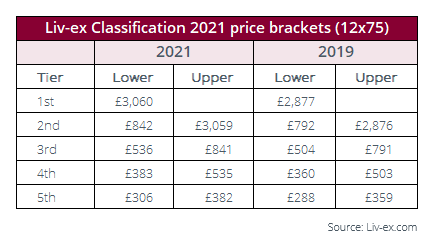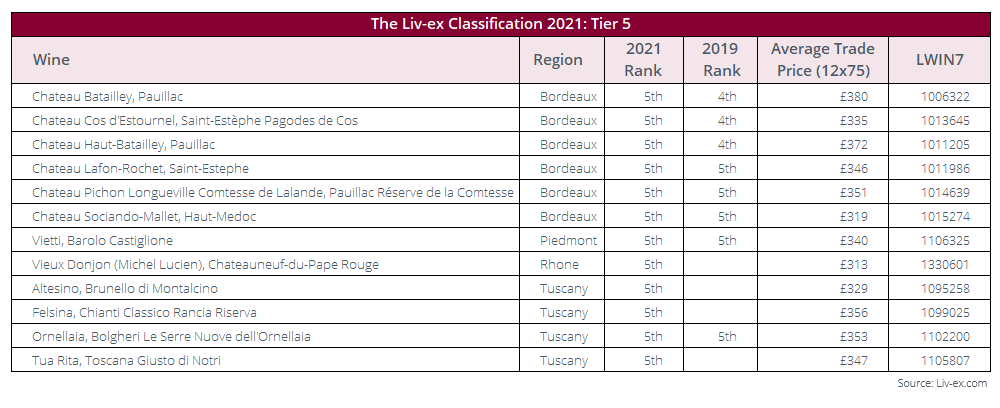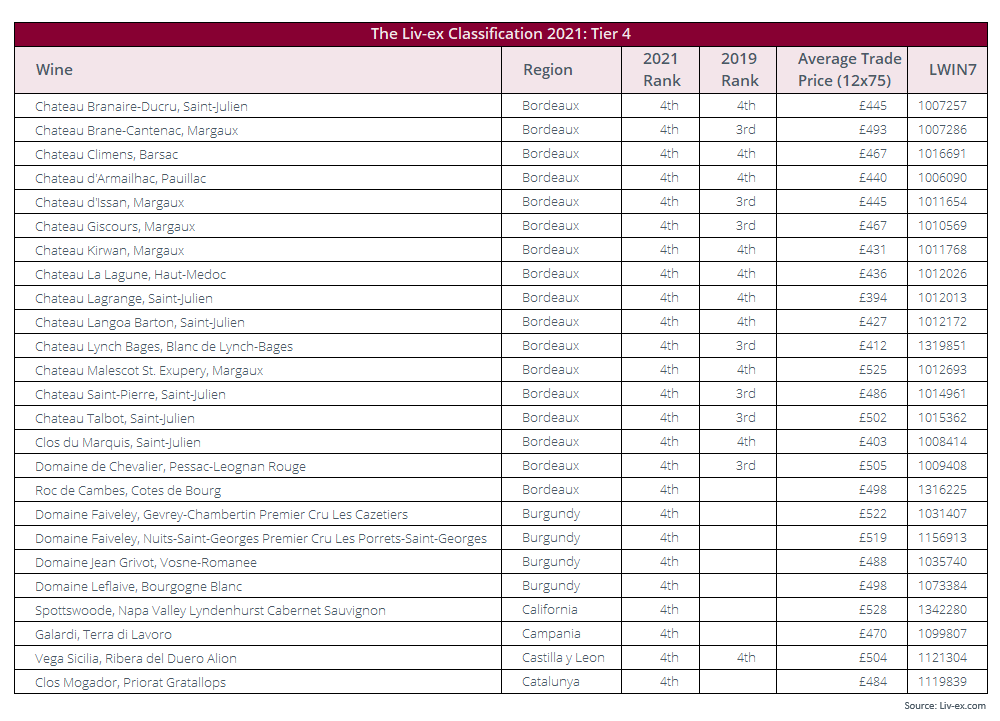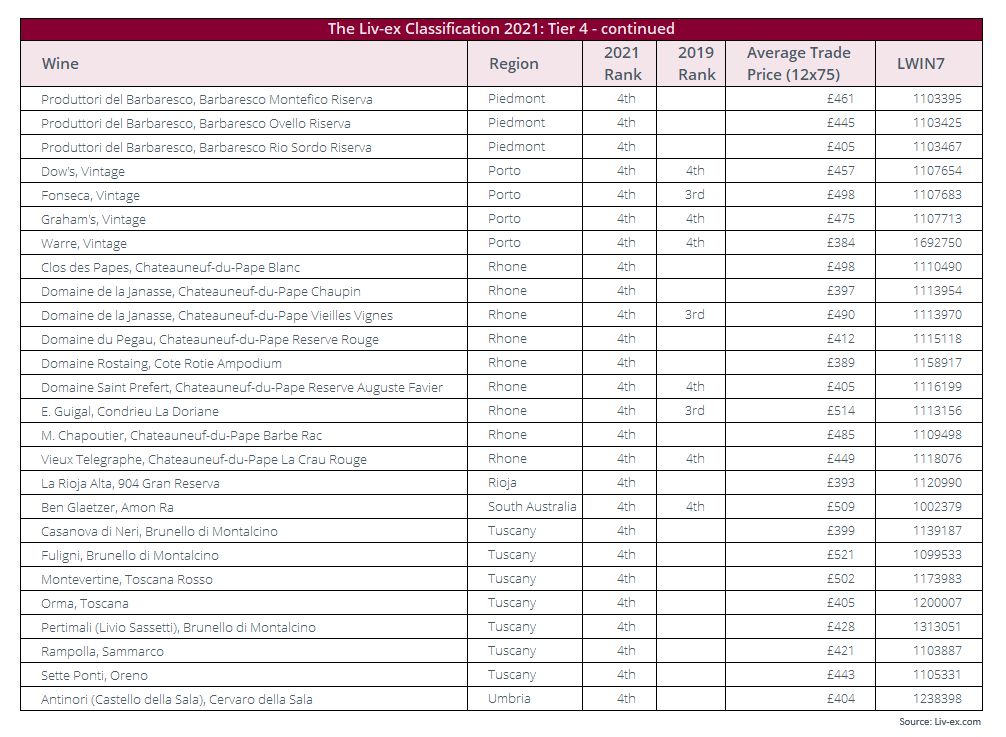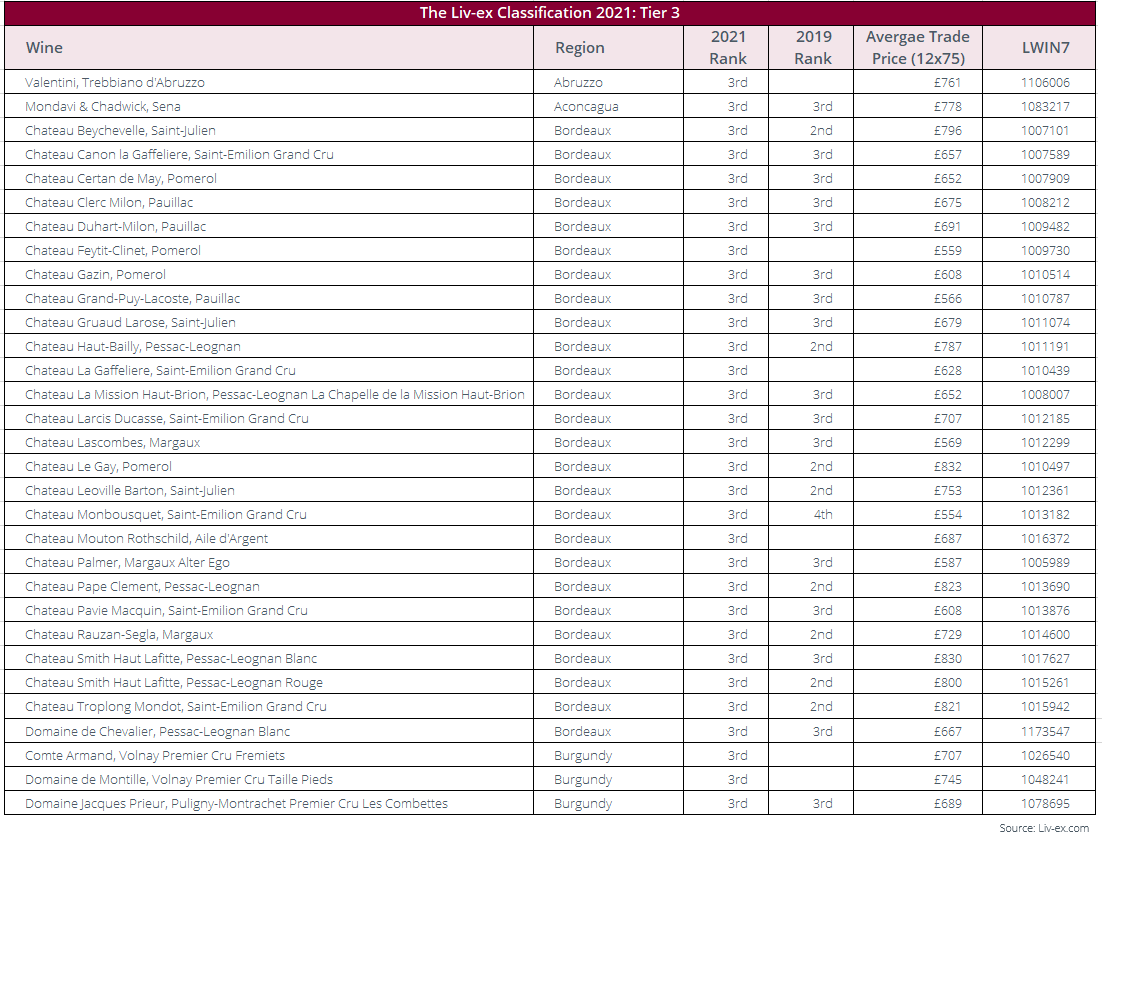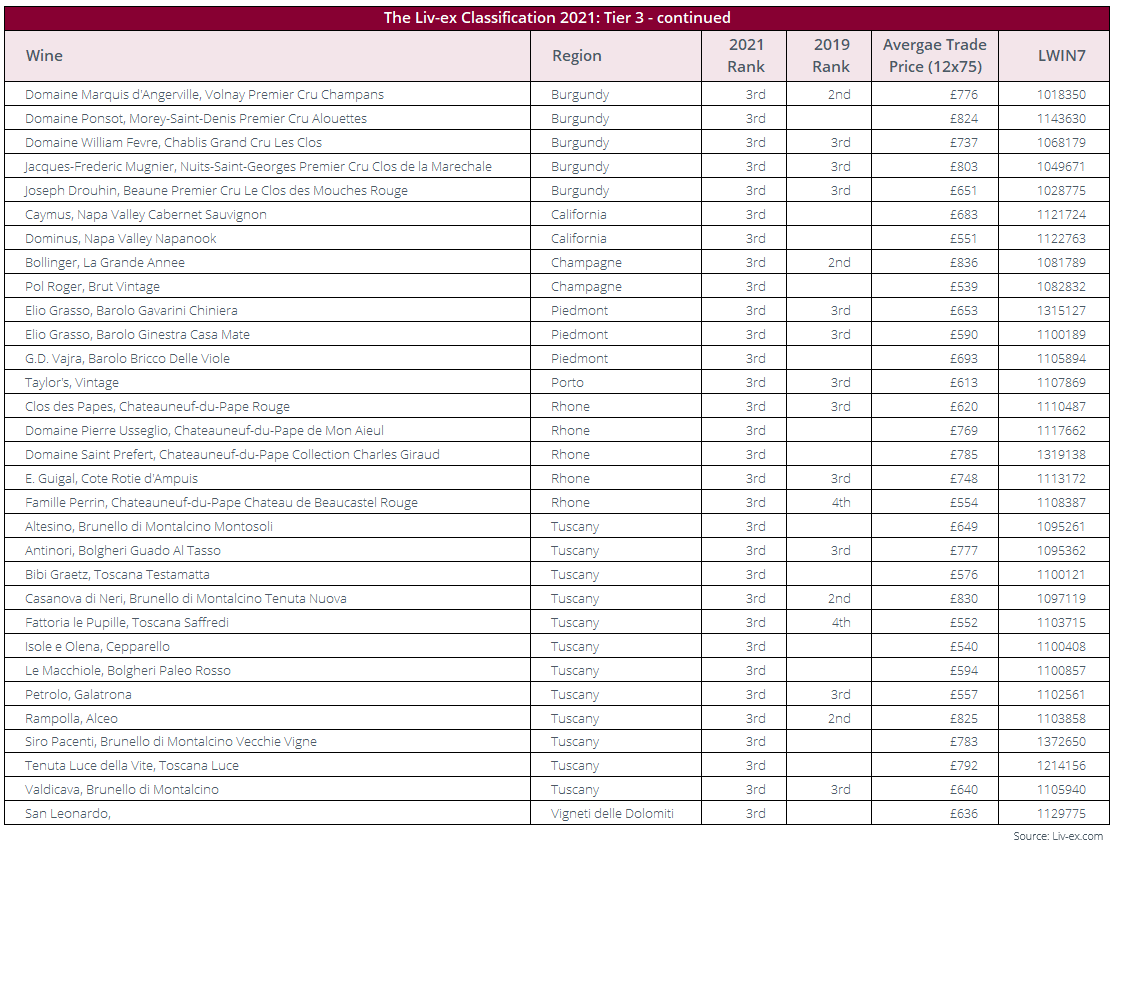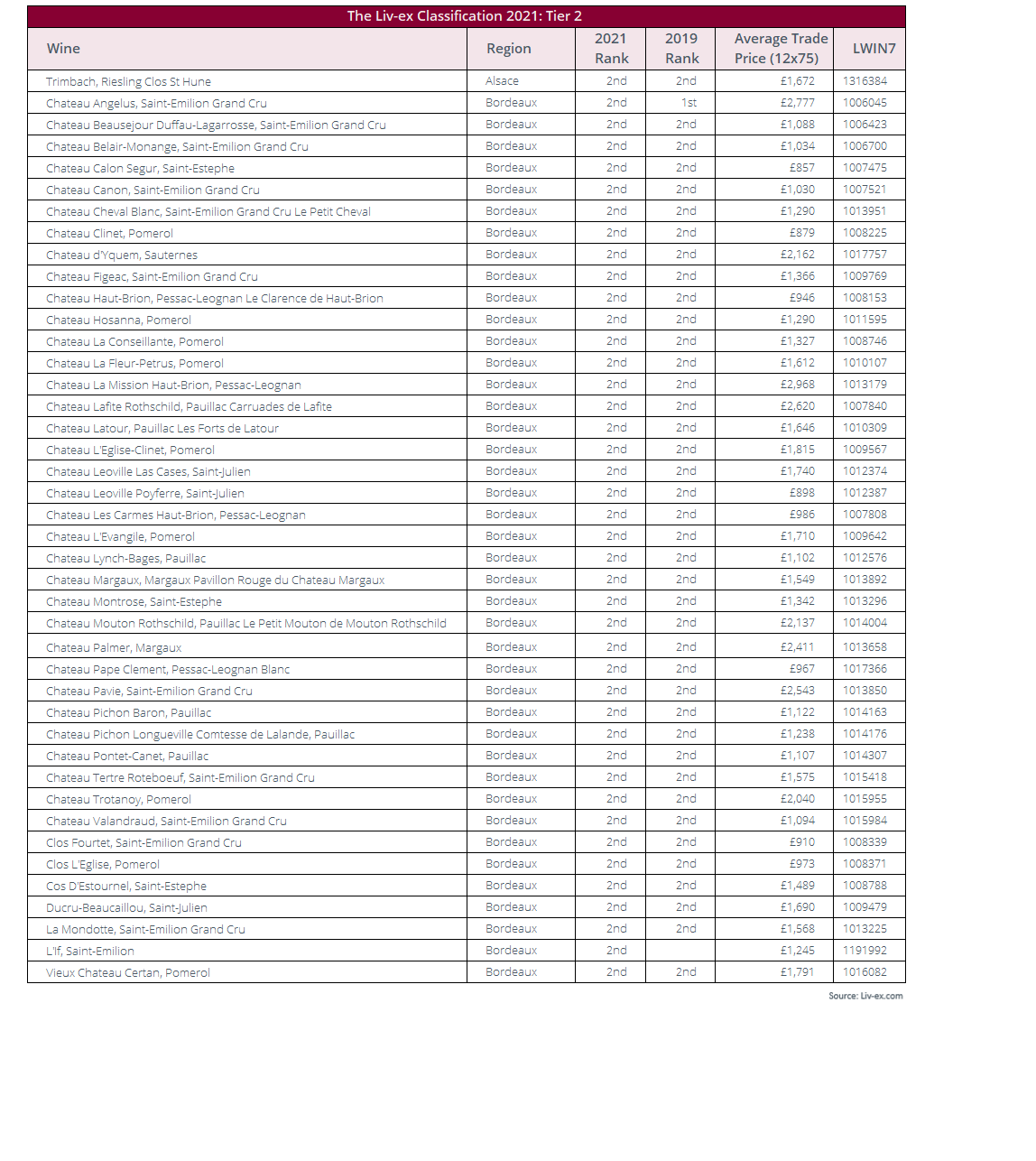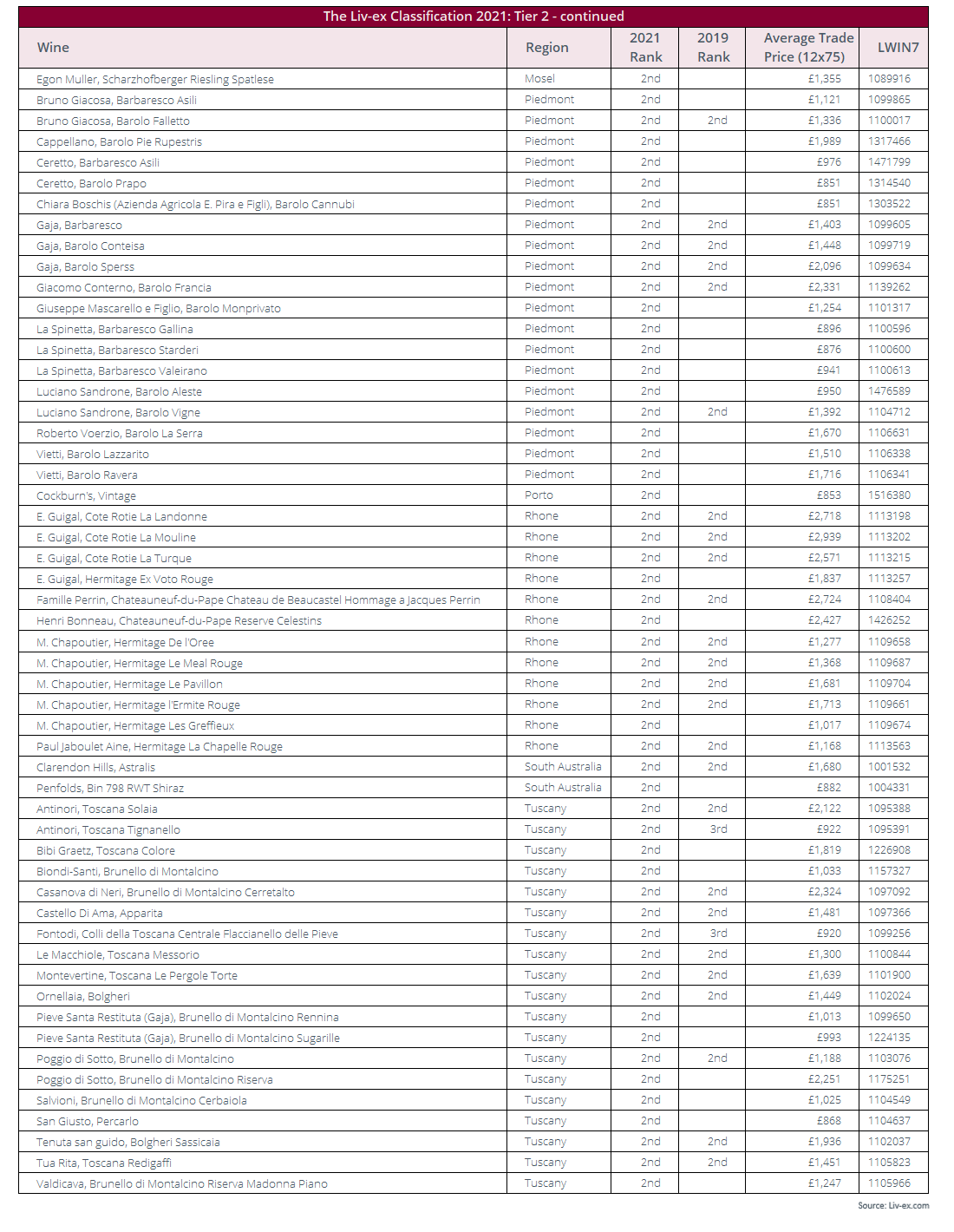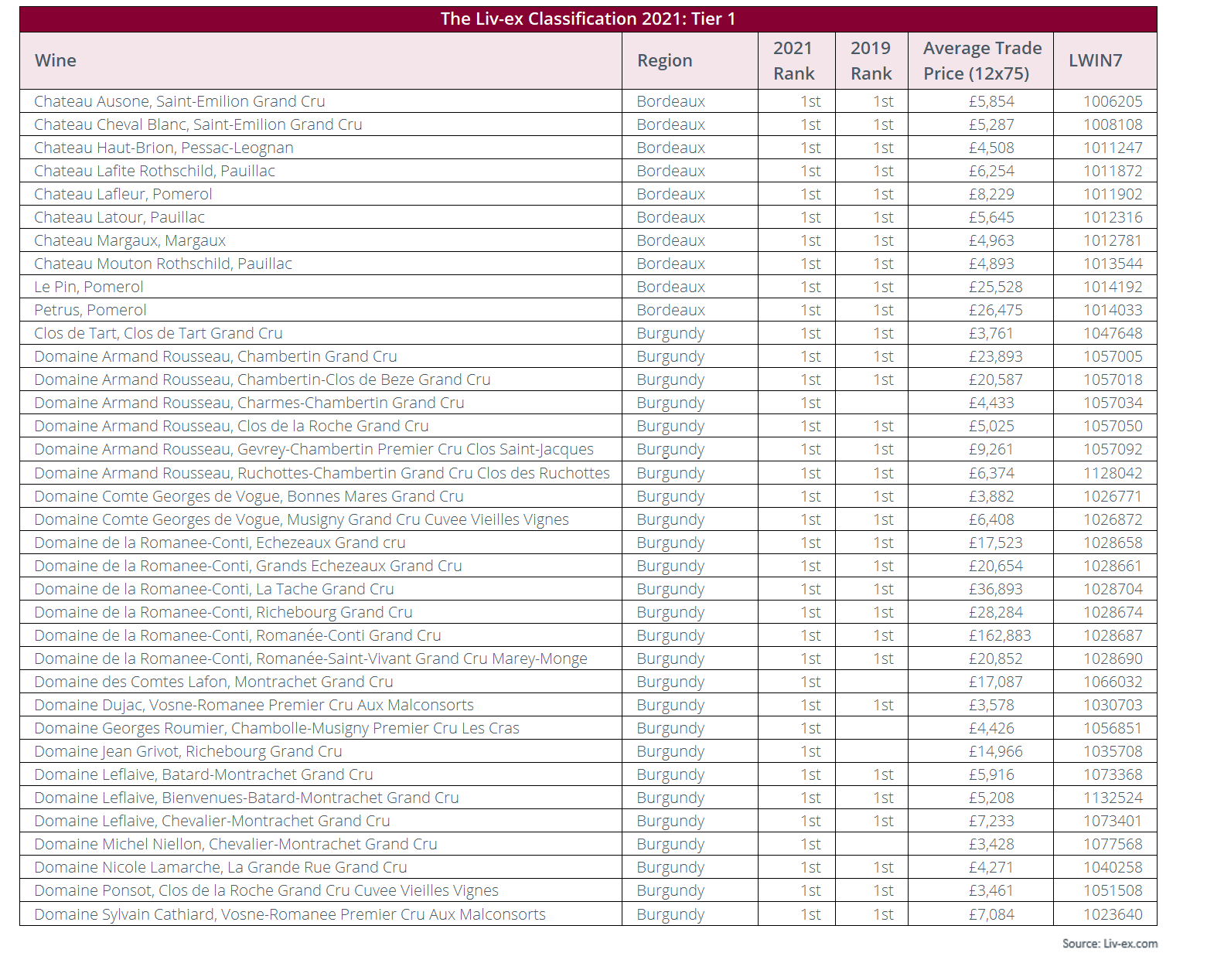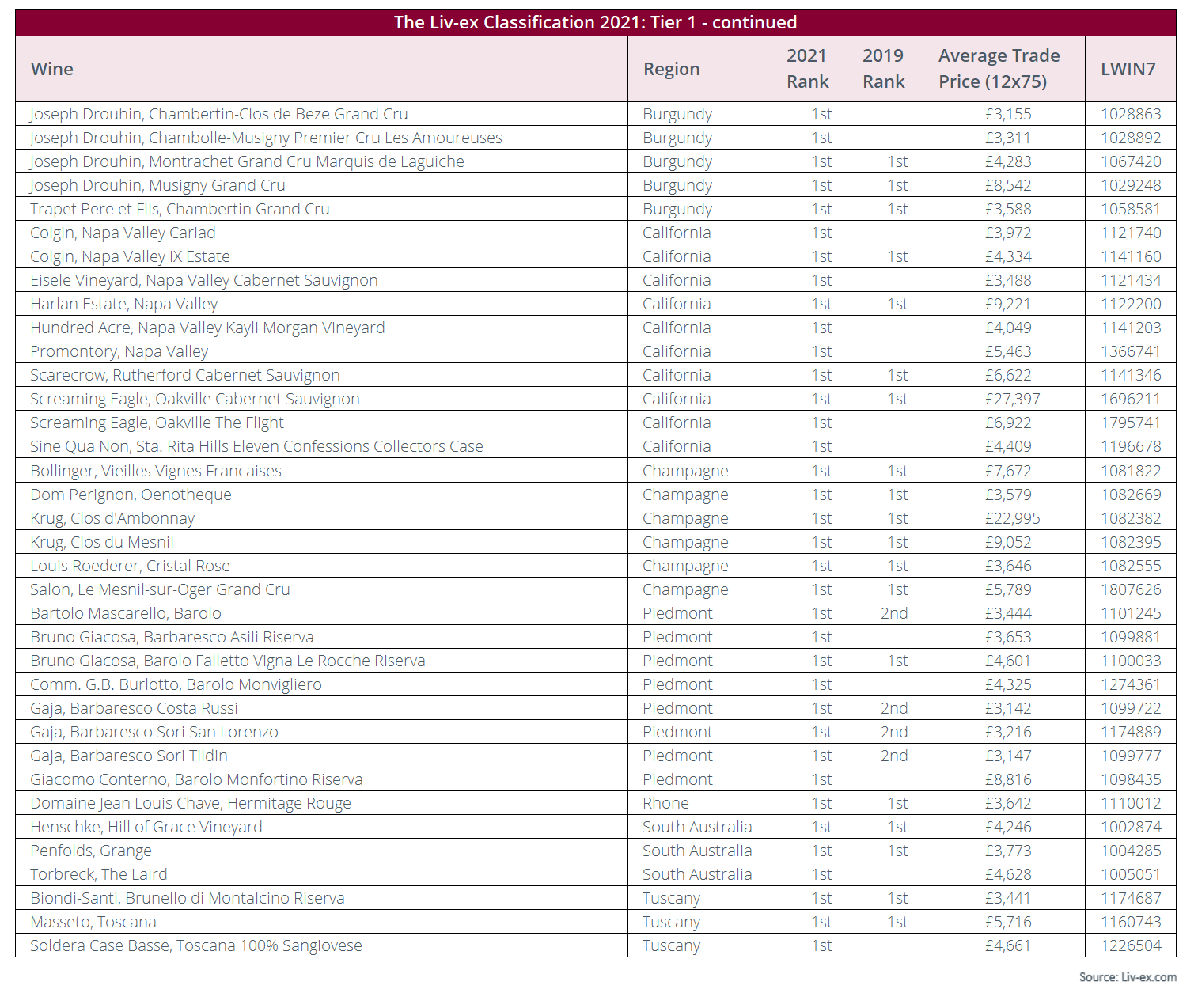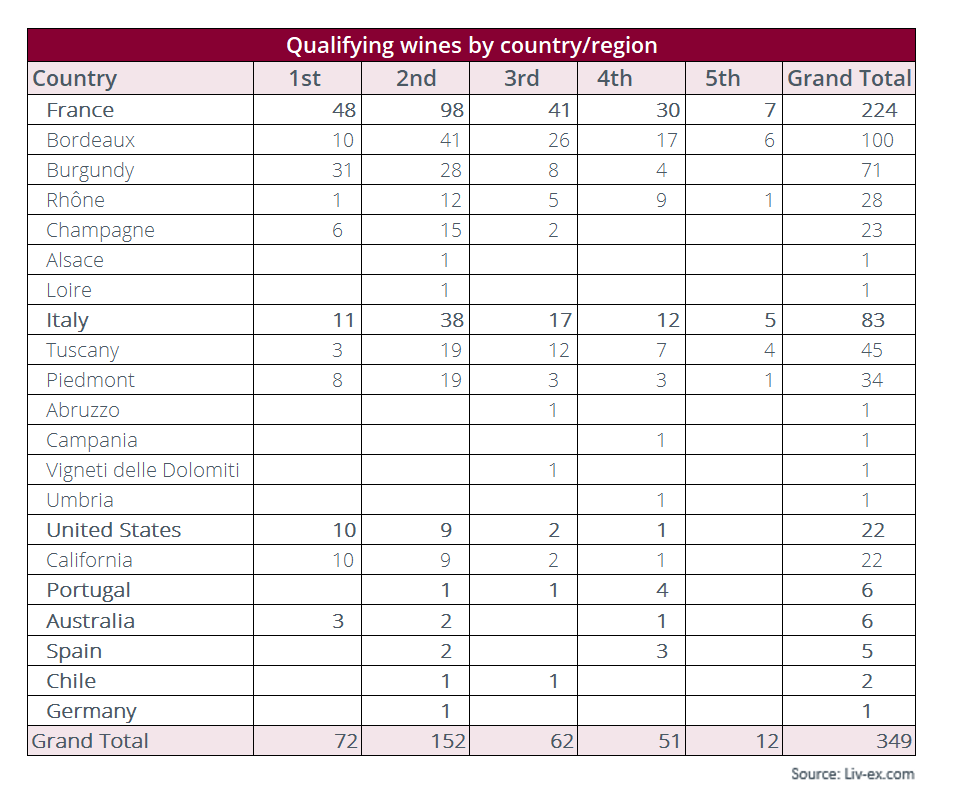Print and read offline instead
Introduction
In the last Liv-ex Classification, in 2019, the fact that the fine wine market was expanding beyond Bordeaux and even Burgundy became increasingly apparent.
Having run the Liv-ex Classification since 2009, it was only in 2017 that the classification was opened up to include wines from around the world, not just Bordeaux.
In 2017, wines from six countries qualified for the list. This rose to nine in 2019. This has dropped to eight countries in this year’s classification but the number of non-Bordeaux wines that qualified has continued to rise. Two regions in particular have doubled their number of entrants.
Italy and the US have been the big winners in this year’s classification but Australia has also added another label to the top tier.
The aim of the classification remains the same as it did from the outset; using price to determine a hierarchy of the leading labels in the secondary market. Its inspiration is the 1855 Classification in Bordeaux, which ordered the wines from top estates from fifth to first growths using their market price.
Given the scope of wines being considered today and with prices for certain labels (especially in regions such as Burgundy) rising to great heights, a minimum level of activity and number of vintages traded over the last year was also required for a wine to qualify.
This means that one vintage of one very rare label, trading just once for a very great price alone is not enough to secure a place in the classification. As well as organising wines by price, therefore, those labels that have qualified for the final list are those that show the most sustained market interest as well.
Methodology
To construct the 2021 Liv-ex Classification, the following methodology was used.
In order to qualify for the ranking, a wine must have traded on Liv-ex between 1st July 2020 and 30th June 2021 in either a 75cl or 150cl bottle format. Standard in Bond, Standard En Primeur and Duty Paid trades were all considered, except for Burgundy, Champagne, Australia and the USA where special traded were also permitted.
Two additional criteria must have been met:
- Five or more vintages of the wine must have traded during the period.
- The wine must have traded 15 or more times during the period.
Once a wine qualified for inclusion in the rankings, the average trade price per 12x75cl was calculated by dividing the total value traded by the number of 9L cases traded (i.e the volume).
The price bands are updated every two years to reflect the changing conditions of the market. This year we adjusted our price bands in accordance with the performance of the Liv-ex 1000 index. This is because the Liv-ex 1000 is our broadest measure of the market and tracks the performance of wines across the globe.
Between May 2019 (when we last updated our classification) and June 2021, the Liv-ex 1000 rose by 6.36% and the price bands for each tier were adjusted to reflect this. The lowest price bracket was for the 5th tier (between £306 and £382 per 12×75). Therefore, wines that failed to achieve an average trade price of at least £306 per 12×75 did not qualify.
The following price bands for the Liv-ex Classification 2021 are as follows. The price bands for the 2019 Classification have also been given as a comparison.
5th Tier
The 5th tier of the classification is the smallest; composed of just 12 wines, all from France and Italy.
This number is half what it was in 2019. Although the number of wines in the classification overall has stayed the same over the past two years, the fourth and third tier categories have both grown in size.
Four of the wines are new entrants in the qualification and three have moved down from the fourth tier meaning just five are left over from the fifth tier class of 2019.
Up and down
The most eye-catching news in this tier is the downward direction Château Batailley and Haut-Batailley took.
The former in particular has been ranked as a fourth tier label since at least the 2015 Classification. It only very narrowly missed out on retaining its fourth tier positioning with an average trade price of £380 and has seen the most trades for wines by vintage (LWIN11s) of any label in the fifth tier.
Haut-Batailley meanwhile rose into the fourth tier in 2017 following its purchase by the Cazes family. As with Batailley, this Pauillac estate’s average price (£372) is not far off the upper limit for this tier.
With the margins so close, there is every possibility that both could rise again in the 2023 Classification. Nonetheless, their retrograde progress is a pattern repeated by many other Bordeaux labels across the tiers this year as the other installments will show.
Rising tides
As seen in last year’s Power 100, this is not a sign of free-falling prices and lack of interest in Bordeaux. Rather, it is a sign of more wines, more varied wines and more expensive wines trading over the past two years.
With other non-Bordeaux labels increasingly setting the pace in the secondary market, the price boundaries of the Classification are on the move and some labels have been caught out.
The lower limit for the 4th tier in 2019 was £360, a level both Batailley and Haut-Batailley would have comfortably surpassed if that had remained the same. The Liv-ex 1000 has risen 6.3% since then, however, and this rising tide did not lift all ships with it.
4th Tier
The biggest expansion
The 4th tier of the classification is the second smallest, featuring 51 wines that fell into the price band of £383-£535 per 12×75. It is, however, the tier that has undergone the biggest expansion since the last Liv-ex Classification in 2019, up 38% from 37 wines.
Tier 4 continues to reflect the sustained broadening of the market, including 30 wines from France, 12 from Italy, four from Portugal, three from Spain, and one apiece from the USA and Australia.
A deepening market
The Rhône and Italy have enjoyed the biggest growth since the last classification, a reflection of the price performance of both regions. The number of labels from the Rhône has risen from three to nine – five of these were new entrants.
Italy has quadrupled its presence, up from three to 12 labels in the 4th tier. And while Tuscany dominates, as already seen in Tier 5, the 4th tier showcases the increased breadth and depth of Italian wines that see sustained market demand – and at relatively high prices – with brand new additions from Umbria and Campania.
The fine wine market is not only broadening, with more countries being represented, but deepening, with more regional moves.
New (World) moves
Spottswoode’s Lyndenhurst Cabernet Sauvignon is another new entrant to the classification and the sole US representative in the 4th tier. California has secured a strong presence in this year’s rankings, which is no surprise to those following the development of the fine wine market’s leading non-European region. Liv-ex members can read our first in-depth Californian report, titled “A Golden Era for the Golden State”.
Australia, meanwhile, has been more passive on the secondary market (in part due to China’s tariffs) yet Ben Glaetzer’s Amon Ra has managed to maintain its position in tier four.
A trip to Iberia
The 4th tier features more wines from Spain and Portugal than any other tier.
Three wines from Spain qualified, up from one in 2019: Vega Sicilia’s “Alión” label, which kept its place, and two fresh risers – Clos Mogador’s “Gratallops” and La Rioja Alta’s 904 Gran Reserva.
Port powerhouses Dow’s, Graham’s, Warre’s and Fonseca were all classified in the 4th tier, with Fonseca dropping one tier from the 2019 classification.
Less Bordeaux
Seventeen wines from Bordeaux were listed in the 4th tier, down from 21 in 2019.
Some wines have dropped a tier for reasons highlighted above: with non-Bordeaux increasingly setting the pace in the secondary market, some labels have narrowly missed the new price margins.
These include Domaine Chevalier, Talbot, Saint-Pierre, Lynch Bages, Giscours, d’Issan and Brane-Cantenac, which – however, tables might turn again in the 2023 Classification.
The 4th tier also welcomed a new Bordeaux label – Château Roc de Cambes, Côtes de Bourg.
New Burgundy
Due to its high prices, Burgundy tends to dominate the very top tiers, and be absent from the lower levels. As we have frequently pointed out, however, secondary market demand for Burgundy has broadened recently as buyers seek out value.
The four wines from Burgundy that were listed in the 4th tier are all new additions to the classification. These are Domaine Faiveley’s Gevrey-Chambertin Premier Cru Les Cazetiers and Nuits-Saint-Georges Premier Cru Les Porrets-Saint-Georges, Domaine Jean Grivot’s Vosne-Romanée and Domaine Leflaive’s Bourgogne Blanc.
3rd Tier
The 3rd tier grew from 50 to 62 wines from 2019 to 2021, a rise of 24%. This category had a total of 20 new entrants but also the highest number of wines that dropped down a level from the 2019 Classification. A total of 12 labels that were classed as 2nd tier two years ago are now 3rd tier.
Going the other way, only three wines were promoted from 4th to 3rd tier and two have risen up into the 2nd tier since 2019.
Fallers
At the core of the 3rd tier is Bordeaux, with 26 labels. Eight of these were classed as 2nd tier wines in 2019: Beychevelle, Haut-Bailly, Le Gay, Léoville Barton, Pape Clément, Rauzan-Ségla, Smith Haut Laftte (Rouge) and Troplong Mondot.
As in previous categories, these labels are easily surpassing the minimum level for the number of vintages and trades required for inclusion in the classification. Their average case prices, however, have not kept up with the movement of the wider market.
That said, several of the new additions are from Bordeaux. These include Feytit-Clinet and La Gaffelière from the Right Bank as well as Mouton Rothschild’s white wine, Aile d’Argent.
Other labels that were relegated from the 2nd tier in 2019 include Bollinger’s La Grande Année, Domaine Marquis d’Angerville’s Volnay Premier Cru Champans and two Tuscan labels.
Diversity of new entrants
Nine of the new wines are Italian and while five of those are Tuscan, there was also a new listing for wines from the Dolomites (San Leonardo) and Abruzzo (Valentini’s Trebbiano d’Abruzzo). Not all Italian labels in the secondary market are Tuscan or Piedmontese.
A further sign of the broadening Burgundy market was the inclusion of three new premier crus. A Volnay may have fallen a tier but it was joined by two more, Domaine Montille’s “Taille Pieds” and Domaine Armand’s “Fremiets”, as well as Domaine Ponsot’s Morey-St-Denis “Alouettes”.
Pol Roger’s vintage brut also made its classification debut in this tier as did two Châteauneuf-du-Pape from Domaine Pierre Usseglio and Domaine Saint Prefert. They joined the Châteauneuf from Clos des Papes, which was a 3rd tier wine in 2019, and Famille Perrin’s Château de Beaucastel which rose from 4th to 3rd tier.
A large and well-known AOC in the Southern Rhône, Châteauneuf-du-Pape offers an affordable and high quality entry point into the region’s wines. In April this year we noted it had been enjoying its best year of trade since 2010.
Also of note was the inclusion of two new Californian wines; Caymus and Napanook from Dominus in what is otherwise the second smallest tier for California in the classification. There were, however, no Californian wines in this tier (or the 4th tier) in the 2019 Classification, highlighting the growing spread of the region’s wines throughout the secondary market.
2nd Tier
In line with previous editions of the Liv-ex Classification, the 2nd tier is the largest, with 152 wines falling in the price bracket of £842-£3,059 per case.
The second tier is also the broadest, featuring wines from Chile, the USA, Italy and France, and the only wine from Germany. It also includes the first 2nd tier wine for Portugal – Cockburn’s Vintage Port.
This year, tier two contains 54 new additions, three fallers, and two risers (up from tier three).
Moving between the tiers
Super Tuscan label Tignanello and Fontodi’s Flaccianello delle Pieve Colli rose from tier three, a level they had held since the classification became global in 2017. With an average trade price of just over £920 per case, Tignanello and Fontodi now join the ranks of Tua Rita, Solaia, Ornellaia and Sassicaia.
And while the risers were both from Tuscany, the three fallers – dipping from their 1st tier position, achieved in the 2019 Classification, came from Bordeaux, Burgundy and Champagne. Their average trade price has fallen since the last rankings, while the margins for inclusion have risen.
Château Angélus – a Premier Grand Cru Classé A since 2012 – has returned to the 2nd tier, where it was placed in the 2017 Classification. Its average trade price has fallen from £2,906 to £2,777, while the minimum price for the upper tier is now £3,060. For the same reason, Dom Pérignon’s P2 and Joseph Roty, Charmes-Chambertin Grand Cru Très Vieilles Vignes have dropped a tier.
German substitutions
In the 2019 Liv-ex Classification, the only German wine that featured (again in tier two) came from Rheinhessen: Keller’s Westhofener Brunnenhauschen Abtserde Riesling GG, which had an average trade price of £2,555 per 12×75.
In the 2021 Liv-ex Classification, Keller gave way to a Riesling from Mosel: Egon Müller’s Scharzhofberger Riesling Spätlese, with an average trade price of £1,355 per case. The wine has seen sustained demand, with eight vintages actively trading over the past year. It is also the most traded German wine (LWIN7) by both value and volume during the last two years.
Italy – an even split
The 38 Italian wines that ranked in the 2nd tier, up from 23 in the 2019 Classification, represented an even split between Tuscany and Piedmont, with 19 each from the country’s leading fine wine regions.
On average, the Tuscan wines traded for £1,420 per case; Piedmont’s 2nd tier came at £1,348.
The most affordable wine from Tuscany was a new addition, San Giusto, Percarlo (£868), and the most expensive – Casanova di Neri, Brunello di Montalcino Cerretalto (£2,324), which retained its 2nd tier status.
Piedmont’s entry point into the 2nd tier was also due to new additions – Ceretto Barolo Prapo and Chiara Boschis (Azienda Agricola E. Pira e Figli), Barolo Cannubi, both carrying an average trade price of £851 per case. The most expensive 2nd tier wine from Piedmont was Giacomo Conterno’s Barolo Francia (£2,331).
Tuscany and the rise of Brunello
Many of the new Italian additions to the 2nd tier of the Liv-ex Classification came from Brunello di Montalcino, including Biondi-Santi’s Valdicava Riserva Madonna Piano, Pieve Santa Restituta’s Rennina and Sugarille, Poggio di Sotto’s Riserva and Salvioni’s Cerbaiola.
Another notable new addition from Tuscany is Bibi Graetz “Colore”, the 2019 vintage of which is expected through La Place this September.
New World additions
A new Australian label has entered the 2nd tier – Penfolds’ Bin 798 RWT Shiraz, with an average trade price of £882 per case.
The Chilean label Almaviva, a joint venture between Baron Philippe de Rothschild and Concha y Toro, re-joined the 2nd tier, after dropping from the 2019 Classification.
California also produced some rising stars, including second label Opus One Overture (which joined Opus One in the 2nd tier), Realm Cellars’ The Bard, Spottswoode’s Cabernet Sauvignon and Ulysses’ Cabernet Sauvignon.
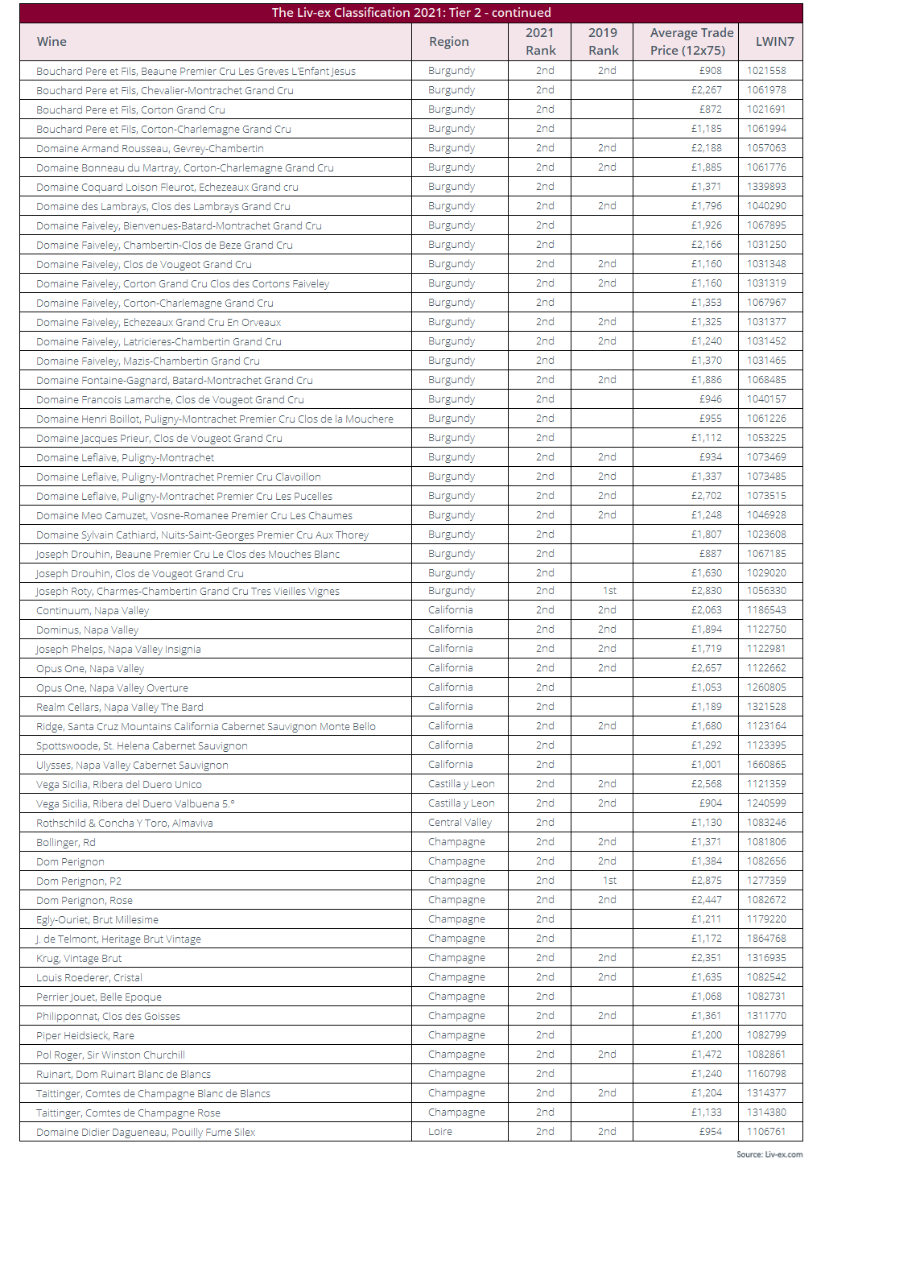
1st Tier
A quick skim of the 1st tier of the classification will reveal few obvious surprises. The top wines of the world, the leading crus classés of Bordeaux, great grands crus of Burgundy, most exclusive Champagnes, Australia’s top Shiraz, cult Californians etc. continue to command the leading prices in fine wine.
There have been a few key changes to the top tier since 2019, however. The number of 1st tier wines for instance declined from 77 in 2019 to 72.
Four wines that were in the 2nd tier in 2019 have risen into the 1st tier – all of them Piedmontese. The 1st tier is the only level of the classification where wines from Piedmont outnumber their Tuscan counterparts – eight wines to three.
Three wines fell out of the 1st tier as the previous section relates, while there were a total of 18 new entrants. These were largely split between Burgundian wines (seven) and Californians (six), with a further three from Piedmont, one from Tuscany and one from Australia.
As in other sections the number of Bordeaux labels declined, from 14 in 2019 to 10 this year. It is important to note though that the tally of Burgundian wines in the 1st tier also went down.
Rise of the rest
There were 44 Burgundian wines in the 1st tier of the 2019 Classification. Even if seven labels are brand new entrants this year, the final number of Burgundians at this level is 31 – a decline of 29.5%.
It is worth noting that of the new Burgundian entries, five of them are priced between £3,155 and £4,433. This is much less than the average for 1st tier Burgundy and again evident of a broadening of the secondary market for this region as prices at the top rise.
Where France’s leading regions have taken a step back, others have stepped into their place. California has gone from having six to 10 labels in the 1st tier equal to Bordeaux’s number of qualifiers.
As the recent California Report made plain, Californian estates have some of the highest average prices in the market. With more activity surrounding Californian wines, so more of its labels have therefore qualified for the classification.
New Californian entries in the 1st tier include a second wine for Colgin, with the “Cariad” joining the “IX Estate”. Eisele, Hundred Acre’s Kayli Morgan Vineyard, Promontory, Screaming Eagle’s second label “The Flight” and one of Sine Qua Non’s wines.
Of the eight Piedmontese wines at the top, only one was a 1st tier wine in 2019 (Bruno Giacosa’s Barolo Falletto Vigna Le Rocche Riserva). The rest either rose up from the 2nd tier or are newly minted, such as another wine from Bruno Giacosa and one the Monfortino Riserva from Giacomo Conterno.
There may be more Tuscan labels in the classification as a whole, but these northern Italian wines are starting to deliver on their moniker of the “Burgundy of Italy”.
Masseto and Biondi-Santi’s Brunello di Montalcino Riserva were joined by fellow Tuscan Soldera Case Basse, while the Australian duo of Penfolds Grange and Henschke’s Hill of Grace were joined by Torbreck’s top label, “The Laird”.
Conclusion
This year’s classification really cements the secondary market trends we have highlighted on numerous occasions over the past year.
These have included the declining share of Bordeaux trade, the diversification of the market with Italy, Champagne, California and the Rhône seeing increased activity and the broadening of the market even within leading categories, such as Burgundy, as buyers seek value.
The classification is a microcosm of all these trends and they can be seen across almost every tier.
General trends
Bordeaux’s share of trade in the secondary market has been in decline over the past few years. This has been reflected in the composition of the classification over time as well.
In 2019, Bordeaux labels constituted just over 37% over the classification list, this year it is just 28.6%. This is some way below Bordeaux’s actual share of the secondary market by volume or value by is illustrative of the general trend nonetheless.
Interestingly, the number of Burgundian wines on the list also declined by 30%. In 2019 there were 102 Burgundy labels, representing 29% of the total. In 2021 there are just 71, 20% of the whole.
The Burgundy 150 index did decline from late 2018 to early 2020 but has bounced back strongly. Prices for the leading wines topped out a little and the category’s momentum slowed. Interest in Burgundy did not go away, however.
Instead it filtered out and down to other grands and premiers crus that looked more immediate value. The scale of the broadening Burgundy market was examined back in April, and showed the rising level of LWINs over the past three years.
The real winners of this year’s classification, however, have undoubtedly been Italy and the US. Italy, with 83 wines, saw a 112% increase from 2019, while the US (entirely represented by California) rose 120% from 10 to 22 wines. Its 6.3% share of the list isn’t far off its 7% share by value of the secondary market either.
The Rhône rose 12% from 25 to 28 wines, Champagne qualifiers increased 27.7% to 23 wines, Chile increased 100% from one to two wines and Portugal held steady on six.
In total there were 120 new entrants to the classification this year – 34% of the total. Over 70% of these were not from Bordeaux or Burgundy.
Less but more
Although the number of countries represented fell from nine in 2019 to eight this year (an Argentine wine failed to qualify in 2021), the number of non-Bordeaux and Burgundy wines rose greatly.
There was also more depth to many countries’ presence as well. In 2019, US wines only appeared in the top two tiers, this year they were spread across four. Bordeaux, Tuscany, Piedmont and the Rhône had wines across all five tiers. Burgundy was found across four tiers, Portuguese and Australian across three.
Buyers are casting their net wider in general and deeper within categories in the search for greater value. And, whether from £300 to £3,000+ per case, they are finding it.

